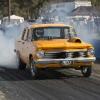Extractors 6->3->1 vs 6->2->1
#1
 _Ned Loh_
_Ned Loh_
Posted 24 October 2011 - 05:41 PM
Can anyone educate me on 6->3->1 vs 6->2->1?
While I am here. Most people seem to focus on primary size, primary length, and collector. What about the importance of secondary size and length?
Cheers.
#2
 _Ned Loh_
_Ned Loh_
Posted 25 October 2011 - 03:26 PM
I've never had a close look at the HM9C but these might be similar? Given HM9C are genrally regarded as the best 'off the shelf' system, why don't we see more 6->3->1? I imagine that they would be harder to make, but is that all?
Can programs like pipemax model these differences?
#3
 _CraigA_
_CraigA_
Posted 25 October 2011 - 05:03 PM

#4
 _sunburst73-xu1_
_sunburst73-xu1_
Posted 25 October 2011 - 06:52 PM
#5
 _oldjohnno_
_oldjohnno_
Posted 25 October 2011 - 07:09 PM
It's worth noting that the 6>3>1 headers have been used in quite a few OEM applications, and I guess that this would support my hunch that a well optimised header of this type can give the best results on a tightly specced engine. So if you had the time and money to do the dyno testing these are the ones to use. Otherwise I'd stick with 6>2>1s and be confident that I'd be within a bees dick of the optimum anyway.
Rules of thumb: the primary pipe diameter will based on the head flow and cam timing. Or the HP output, which is another way of saying the same thing really. Being a tad small here seems to hurt the output a lot less than being too big. Length is based on EVO timing and the torque peak rpms.
The collector dimensions seem to affect the output above and below the peak more than the actual peak. Here, too long seems to be less of a handicap than too short, and extra length seems to help fill in the curve under the peak.
Modelling this stuff can be bloody messy, the interference designs (eg 6>3>1) especially. I tend to take anything that the low end software (ie priced in the 100s rather than 1000s) spits out with a grain of salt. The only possible exception would be Pipemax; it seems to work very well with simple designs but I'd still view it's numbers for complex layouts as being just a starting point. The better packages can model nearly any layout quite accurately but they're not cheap nor quick and easy to use.
#6

Posted 26 October 2011 - 07:54 PM
#7

Posted 26 October 2011 - 08:27 PM
#8
 _Bomber Watson_
_Bomber Watson_
Posted 26 October 2011 - 08:49 PM
Cheers.
#9
 _oldjohnno_
_oldjohnno_
Posted 26 October 2011 - 09:11 PM
One of the interesting things about pipe tuning is that the more powerful you try to make the scavenging wave the narrower the rpm range it will work over, and the more likely that it will create some pretty nasty dips in other parts of the curve. Look up "megaphonitis" (a common problem with Manx Nortons) to see how horrendous it can be. There are certain rpms where the engine will barely run at all let alone make any power.
#10
 _Bomber Watson_
_Bomber Watson_
Posted 26 October 2011 - 09:31 PM
#11
 _oldjohnno_
_oldjohnno_
Posted 27 October 2011 - 06:59 AM
I wish it was that simple. Exhaust tuning can be really messy and it's not something that can be covered in a couple of paragraphs. Blair is your best bet if you want to learn more. But in really simple terms, the important thing we want from the exhaust is a strong negative pressure wave returning to the chamber during the overlap period. This can be much stronger than you'd expect, and can actually exert a stronger pull on the intake runner than the piston does as it moves down. It's not all that important with modern 4 valvers but our asthmatic old 6 pot wheezers really benefit from jerking the fresh charge in early. I remember someone here (Warren?) reported picking up 2 tenths with a simple header swap, so it really is important.So the bigger the hole the primaries are dumping into the easyer it is to tune and the broader the power band?
Now, you can make this happen simply by using a primary pipe of appropriate diameter and length, and six individual pipes would make around the same peak power as any other design. But there are advantages to grouping them into a common collector. One is that you can tune the collector to some extent to extend the curve above and below the peak. An abrupt change in CSA will return a strong negative wave, but over a relatively narrow rpm band. A gently expanding CSA (like a merge collector) will return a less powerful wave but will be effective over a wider range. So collector design probably has more to do with the transmission/converter than anything else. The other thing is that the collector creates a low pressure zone for each tube to dump into and this helps reduce reversion and holes in the torque curve too. If you can get three or more dumping into each collector at even intervals this will work very well.
And in this regard our sixes have quite an advantage over the V8 guys with regular 2 plane cranks: a V8s firing order doesn't alternate evenly between bank to bank so there are variations in the intervals between pulses into each collector. So whatever you do with the pipes is going to be a compromise and you'll never get it perfectly tuned for each cylinder. This is also why they like X-pipes and crossovers so much, they help to provide a more consistent pull on each side. With a straight six though, we have an almost perfect layout for a very efficient exhaust and I suspect that this may be one reason why some manufacturers of very high output sixes (eg. BMW) have stuck with them.
#12
 _Bomber Watson_
_Bomber Watson_
Posted 27 October 2011 - 06:38 PM
We will discuss this at lengh at a later date.
Cheers.
#13
 _oldjohnno_
_oldjohnno_
Posted 27 October 2011 - 07:47 PM
We will discuss this at lengh at a later date...
Bring beer.
#14

Posted 27 March 2015 - 07:55 PM
Diggin this up,
So which cylinders is better to go together? So firing order 1-5 together? 3-6 then 2-4?
#15

Posted 27 March 2015 - 07:57 PM
Sorry 1-5-6 then 6-2-4 then join in a collector
#16
 _hutch_
_hutch_
Posted 27 March 2015 - 08:03 PM
#17
 _Bomber Watson_
_Bomber Watson_
Posted 27 March 2015 - 08:28 PM
I think plumbing them that way would leave some pretty big holes in the pulses Stedz.
123 and 456 grouped in pairs would give even pulses methinks.
or for a 6-3-1 I recon it would be 1-6 5-2 and 3-4
Cheers.
#18

Posted 27 March 2015 - 09:06 PM
Dave did this:-
The collector is back by the bellhousing. Three pipes on top... 153 left to right, and three below... 624, right to left. I managed to get the length of the pipes within a quarter inch of each other.
But so much heat!!! Sounded awsome though.
http://www.gmh-toran...it/#entry891410
#19

Posted 27 March 2015 - 09:07 PM
Hutch, yes block it off that cylinder is useless, and I prefer to have 2 pipes coming from number six
haha!
Bomber so we aren't using firing order to cause the pulse,
your method is much easier to make!
#20
 _Bomber Watson_
_Bomber Watson_
Posted 27 March 2015 - 09:14 PM
If you go 153 into one collector you will have a full 360 degrees of crankshaft rotation before the next pulse. 153 will fire into one collector, then 624 into the other one, repeat, so one pulse every 120 degrees for 360 then nothing for 360.
Going 123-456 you get one pulse in each collector every 240 degrees.
Hope that's clear?
#21

Posted 27 March 2015 - 09:18 PM
yep makes sense, now to try and make 2 & 3 piipes as long as 1 and 4&5 and as long as 6
#22

Posted 27 March 2015 - 09:21 PM
So would the primaries be ideally 28 inch long, and the secondaries 12 inch?
#23
 _Bomber Watson_
_Bomber Watson_
Posted 27 March 2015 - 09:29 PM
That depends on about 20,000,000 different factors Dave...
Check out Pipemax.
Cheers.
#24

Posted 27 March 2015 - 09:40 PM
love to get my hands on a copy of pipemax, ive got very large primarys 1 3/4 il try go as straight as possible and then make there way down and back!
should be interesting
Id love to know the secondary pipe suggestions from pipe max as well
#25

Posted 27 March 2015 - 09:44 PM
Anyone got Pipemax that can put in some factors for us?
been reading for a while, and I am down to 1 5/8" x 28" Pr with 2" x 12" S
0 user(s) are reading this topic
0 members, 0 guests, 0 anonymous users














